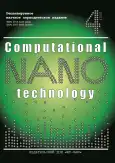Implementation of Intelligent Automatic Control of Traffic Flows in Urban Areas of Regulation Based on the Use of Fuzzy Models
- Authors: Morozov E.A.1, Volosova A.V.2, Matyukhina E.N.3
-
Affiliations:
- Moscow Automobile and Road State Technical University (MADI)
- Bauman Moscow State Technical University
- MIREA – Russian Technological University
- Issue: Vol 10, No 4 (2023)
- Pages: 39-45
- Section: ТЕОРЕТИЧЕСКАЯ ИНФОРМАТИКА, КИБЕРНЕТИКА
- URL: https://journals.rcsi.science/2313-223X/article/view/251949
- DOI: https://doi.org/10.33693/2313-223X-2023-10-4-39-45
- ID: 251949
Cite item
Abstract
The article deals with the implementation of automatic traffic control of automobile flows in urban areas of regulation based on the use of fuzzy models. The relevance of the topic of the article is due to the problem of traffic management in the Smart City ecosystem. Traffic flow control is a complex dynamic task, for the solution of which it is proposed to use artificial intelligence methods for processing fuzzy knowledge. The article proposes a model of a traffic flow control system at an intersection based on the use of fuzzy knowledge. Knowledge processing in the system is carried out by the module “Fuzzy Controller”. The input data for the fuzzy controller is information about the number of cars that have passed and information about the current duration of the traffic light phases. The fuzzy controller has a number of output variables corresponding to the number of phases of the traffic light. The fuzzy controller is implemented by means of the fuzzy sets apparatus. The system solves the following tasks: tracking the increase in traffic in the regulation zone; tracking the approach of the flow density on all streets of the regulation zone to the critical one; collecting information about the filling of the road departing from the intersection; implementing indirect unloading of the road section after the intersection, implementing management in transit sections of the city. To increase the efficiency of the model, an improved traffic management process is proposed within the framework of a single intersection, which takes into account traffic situations after the intersection. This approach has a positive impact on traffic in the regulated area due to the decentralized structure of the system consisting of such controlled intersections. The authors also implement the priorities of the directions of movement within the framework of the proposed model. Priorities are set when setting up the system at each of the traffic lights and allow you to speed up the circulation of traffic within the control zone.
Full Text
##article.viewOnOriginalSite##About the authors
Egor A. Morozov
Moscow Automobile and Road State Technical University (MADI)
Author for correspondence.
Email: legolassuper@gmail.com
PhD student
Russian Federation, MoscowAlexandra V. Volosova
Bauman Moscow State Technical University
Email: volosova@bmstu.ru
Cand. Sci. (Eng.), Associate Professor
Russian Federation, MoscowEkaterina N. Matyukhina
MIREA – Russian Technological University
Email: makaterina_ski@mail.ru
Cand. Sci. (Eng.), Associate Professor
Russian Federation, MoscowReferences
- Konstantinov K.S., Volosova A.V. Application of a genetic algorithm for the organization of traffic lights in order to optimize road traffic. Internauka. 2023. No. 23 (293). (In Rus.)
- Volosova A.V. Using tensor technology to work with unmanaged systems. Computational Nanotechnology. 2023. Vol. 10. No. 1. Pp. 79–87. (In Rus.)
- Maksimychev O.I., Mezentsev K.N., Volosova A.V. Information and communication technologies and elements of artificial intelligence in intelligent transport systems. The World of Transport and Technological Machines. 2023. No. 1-1 (80). Pp. 112–118. (In Rus.)
- Ostroukh A.V., Pronin C.B., Volosova A.V. et al. Parametric synthesis of quantum circuits for training perceptron neural networks. In: Intelligent Technologies and Electronic Devices in Vehicle and Road Transport Complex, TIRVED 2022: Conference proceedings, 2022.
- Pronin C.B., Maksimychev O.I., Ostroukh A.V. et al. Creating quantum circuits for training perceptron neural networks on the pRSCIiples of Grover’s algorithm. In: Systems of Signals Generating and Processing in the Field of on Board Communications, SOSG 2022: Conference proceedings, 2022.
- Yurchik P.F., Maksimychev O.I., Golubkova V.B., Volosova A.V. Tensor analysis of uncertainty in freight transport ULS-systems. In: IOP Conference Series: Materials Science and Engineering. DOI: http://dx.doi.org/10.1088/1757-899X/1159/1/012074.
- Volosova A.V., Matiukhina E. Using artificial intelligence for effective decision-making in corporate governance under conditions of deep uncertainty. In: SHS Web of Conf. 2020. No. 89. P. 03008. doi: 10.1051/shsconf/20208903008.
- Volosova A.V., Matiukhina E., Akimov D. The use tensor method of dual networks for analysis of the transport and tourist components of sustainable development of territories // E3S Web of Conferences. 2020. No. 208. P. 05012.
- Volosova A.V. Implementation of automated drone control using artificial intelligence technologies. Engineer and Industrialist. 2022. No. 4 (58). (In Rus.)
- Maksimychev O.I., Volosova A.V., Ismoilov M.I. et al. Platforms and complexes for unmanned technologies in road transport. In: Intelligent Technologies and Electronic Devices in Vehicle and Road Transport Complex. TIRVED 2022: Conference proceedings, 2022.
- Volosova A.V., Maksimychev O.I., Ostroukh A.V. et al. Uncertainty processing by tensor algebra means in condition of movement along complex roads. In: Systems of Signals Generating and Processing in the Field of on Board Communications. SOSG 2022: Conference proceedings, 2022.
- Kuftinova N.G., Maksimychev O.I., Ostroukh A.V. et al. Data fabric as an effective method of data management in traffic and road systems. In: Systems of Signals Generating and Processing in the Field of on Board Communications, SOSG 2022: Conference proceedings, 2022.
Supplementary files












